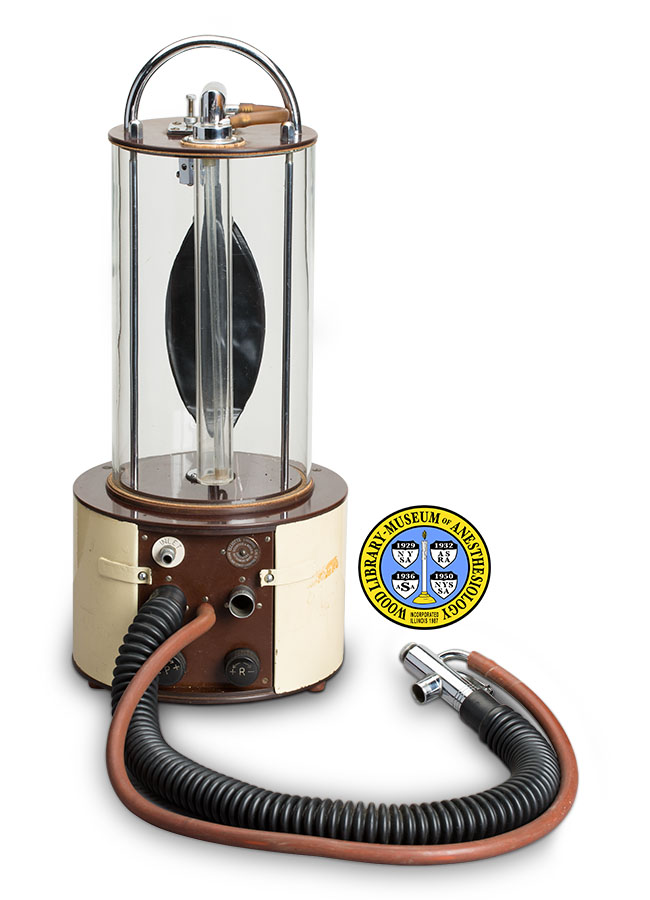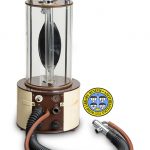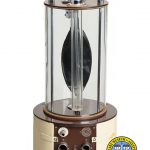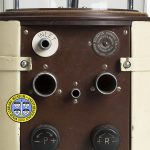Fazakerley Respirator
A ventilator is a machine that helps a person breathe or takes over the work of breathing completely. English engineer and anesthesiologist, Joseph R. Esplen, FRCS, LRCP, FFARCS (1912-1974), invented several devices for use in inhalation anesthesia. Named for two Liverpool hospitals where he worked, the Aintree Ventilator was introduced in 1952, and the Fazakerley Respirator was introduced in 1956. Working primarily with tuberculosis and polio patients, Dr. Esplen had a strong interest in the treatment of respiratory disease, as well the management of the patient's breathing during anesthesia.
The Fazakerley Respirator could be powered either by compressed air or anesthetic gases. It could deliver manually adjusted continuous positive pressure during inspiration, and continuous negative pressure during expiration. The expiratory valve (seen at the end of the red breathing tube) could also be detached from the apparatus and used in conjunction with an anesthesia mask or an endotracheal tube. The respirator was made by the scientific apparatus company, Elliotts Liverpool, Limited in the 1950s and 1960s.
Catalog Record: Fazakerley Respirator Fazakerley Respirator
Access Key: amwj
Accession No.: 2015-12-21-1
Title: [Fazakerley Respirator] / Elliotts Liverpool, Limited.
Author: Esplen, J. (Joseph) R. (Rentoul), 1912-1974.
Corporate Author: Elliotts Liverpool, Limited.
Title variation: Alt Title
Title: Fazakerley Ventilator.
Publisher: Liverpool: Elliotts Liverpool, Limited, [between 1956 and 1980?]
Physical Description: 1 anesthesia ventilator : metals, glass, plastics, rubber, cork, enamel ; 57 x 26 dia. cm.
Subject: Anesthesia, Inhalation – instrumentation.
Subject: Respiration, Artificial – instrumentation.
Subject: Ventilation, Mechanical.
Subject: Ventilators, Mechanical.
Web Link: https://www.woodlibrarymuseum.org/museum/item/1013/fazakerley-respirator
Note Type: General
Notes: In the short physical description, only the body of the apparatus is measured. The connected hoses could be extended in the direction of either width or depth. The front of the apparatus is considered that side on which the connecting ports and control knobs are mounted. None of the descriptions found explain the knobs.
The first year in the date range is that in which the apparatus was introduced, but the design of this example is somewhat different from the original, and it is likely to have been made somewhat later. The second year in the date range is based on the date of the latest description found; it is likely to have been manufactured somewhat earlier.
Note Type: Citation
Notes: J. R. Esplen [Obituary]. British Medical Journal. October 26, 1974;4(5938):234.
Note Type: Citation
Notes: Esplen JR. A new apparatus for intermittent pulmonary inflation. Brit J Anaesth. October, 1952;24(4):303-311.
Note Type: Citation
Notes: Esplen JR. The Fazakerley Respirator. Brit J Anaesth. April, 1956;28(4):176-186.
Note Type: Citation
Notes: Florence AM. Some medical ‘toys’ from Liverpool. In: History of Anaesthesia Society proceedings, Vol. 40. London: History of Anaesthesia Society, 2008:31-41.
Note Type: Citation
Notes: Hewer CL, Lee JA. Recent Advances in Anaesthesia and Analgesia. 8th ed. Boston: Little, Brown, 1957:48.
Note Type: Citation
Notes: Hewer CL. Recent Advances in Anaesthesia and Analgesia. 9th ed. Boston: Little, Brown and Company, 1963:260, 282.
Note Type: Citation
Notes: Hillard EK. A self-contained respirator. Anaesthesia. July, 1958; 13(3):346-347.
Note Type: Citation
Notes: Hunter AR. Essentials of Artificial Ventilation of the Lungs. London: J. A. Churchill, Ltd., 1962.
Note Type: Citation
Notes: Mushin WWL, Rendell-Baker L, Thompson PW, Mapleson WW. Automatic Ventilation of the Lungs. 2nd ed. Oxford: Blackwell Scientific Publications, 1969:570-573.
Note Type: Physical Description
Note Type: Reproduction
Notes: Photographed by Steve Donisch, January 13, 2016.
Note Type: Acquisition
Notes: Gift of Ephraim S. Siker, M.D.
Note Type: Historical
Notes: A ventilator is a machine that helps a person breathe or takes over the work of breathing completely. English engineer and anesthesiologist, Joseph R. Esplen, FRCS, LRCP, FFARCS, invented several devices for use in inhalation anesthesia. Two of these were ventilators, which he named for the hospitals where he held simultaneous appointments. The Aintree Ventilator, introduced in 1952, was named for Aintree Tuberculosis Hospital. The Fazakerley Respirator, introduced in 1956, was named for Fazakerley Infectious Hospital. Located in Liverpool’s Fazakerley ward, both institutions later became part of what is now Aintree University Hospitals. Working with tuberculosis and polio patients, Dr. Esplen had a strong interest in the treatment of respiratory disease, as well the management of the patient’s breathing during anesthesia.
In his description of the apparatus, Dr. Esplen explained both the value and the possible disadvantages of positive pressure ventilation, particularly for long-term ventilation.The Fazakerley respirator was designed to obviate some of the disadvantages by providing support to the patient’s airway through negative pressure. Originally used to assist tetanus patients, who were treated with muscle relaxants and therefore required artificial respiration, it was later used for polio patients.
The respirator could be powered either by compressed air or anesthetic gases. The varying pressure of the gases in the bottle compressed and expanded the breathing bag, which could be attached to the carbon dioxide absorption unit of an anesthesia machine. It could be manually adjusted to deliver the desired level of continuous positive pressure during inspiration, and continuous negative pressure during expiration. The expiratory valve could also be detached from the apparatus and used in conjunction with an anesthesia mask or an endotracheal tube. The respirator was made by the scientific apparatus company, Elliotts Liverpool Limited in the 1950s and 1960s. Two years after it was introduced, Hillard described a modification which combined the Fazakerley Respirator with an air compressor.
Note Type: Publication
Notes: Esplen, Joseph Rentoul [Obituary]. Lancet. 1974.
Note Type: Exhibition
Notes: Selected for the WLM website.




